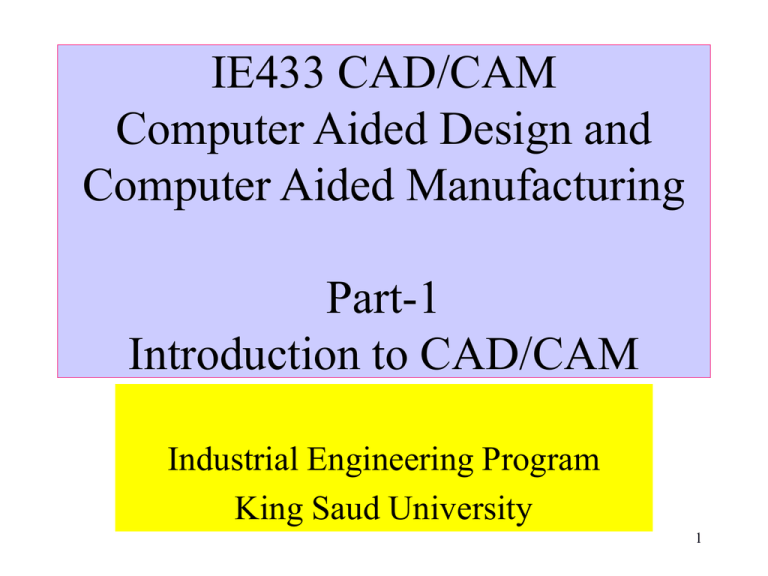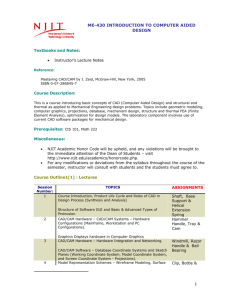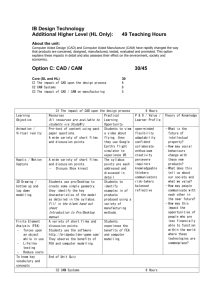cadcampart1
advertisement

IE433 CAD/CAM Computer Aided Design and Computer Aided Manufacturing Part-1 Introduction to CAD/CAM Industrial Engineering Program King Saud University 1 IE433-CAD/CAM • CAD/CAM = Computer Aided Design and Computer Aided Manufacturing. It is the technology concerned with the use of computers to perform design and manufacturing functions. 2 • CAD can be defined as the use of computer systems to perform certain functions in the design process. • CAM is the use of computer systems to plan, manage and control the operations of manufacturing plant through either direct or indirect computer interface with the plant’s production resources. 3 From CAM definition, the application of CAM falls into two broad categories: 1. Computer monitoring and control . Computer Process data Process Process data Computer Process Control signals 4 2. Manufacturing support application . Process data Mfg Computer Control signals operations 5 The Product Cycle and CAD/CAM In order to establish the scope and definition of CAD/CAM in an engineering environment and identify existing and future related tools, a study of a typical product cycle is necessary. The following Figure shows a flowchart of such a cycle. 6 Typical Product Life Cycle The Design Process Design needs Design definitions, specifications, and requirements Analysis Design documentation and communication Collecting relevant design information and feasibility study Synthesis The CAD Process Design evaluation Design optimization Design analysis Design modeling and simulation Design conceptualization The Manufacturing Process Production planning Process planning Design and procurement of new tools The CAM Process Production Quality control Packaging Shipping Order materials NC, CNC, DNC programming Marketing 7 • The product begins with a need which is identified based on customers' and markets' demands. • The product goes through two main processes from the idea conceptualization to the finished product: 1. The design process. 2. The manufacturing process. The main sub-processes that constitute the design process are: 1. Synthesis. 2. Analysis. 8 Implementation of a Typical CAD Process on a CAD/CAM system Delineation of Design changes Design and geometric model Analysis algorithms Definition translator Geometric model Interface algorithms Drafting and detailing Documentation To CAM Process 9 CAD Tools Required to Support the Design Process Design phase Required CAD tools Design conceptualization Geometric modeling techniques; Graphics aids; manipulations; and visualization Design modeling and simulation Same as above; animation; assemblies; special modeling packages. Design analysis Analysis packages; customized programs and packages. Design optimization Customized applications; structural optimization. Design evaluation Dimensioning; tolerances; BOM; NC. Design communication and documentation Drafting and detailing… 10 Implementation of a Typical CAM Process on a CAD/CAM system Geometric model Inspection Interface algorithms Assembly Process planning Packaging NC programs To shipping and marketing 11 CAM Tools Required to Support the Design Process Manufacturing phase Required CAM tools Process planning CAPP techniques; cost analysis; material and tooling specification. NC programming Part programming Inspection Assembly CAQ; and Inspection software Robotics simulation and programming 12 Definitions of CAD Tools Based on Their Constituents Computer graphics concepts CAD tools Design tools Geometric modeling 13 Definition of CAD Tools Based on Their Implementation in a Design Environment Design tools + Computer Hardware (control unit; display terminals; I/O devices = CAD tools Software (graphics; modeling; applications programs 14 Definitions of CAM Tools Based on Their Constituents Networking concepts CAM tools Mfg tools CAD 15 Definition of CAM Tools Based on Their Implementation in a Manufacturing Environment Hardware (control unit; display terminals; I/O devices Mfg tools + Computer Software (CAD; NC; MRP; CAPP…) = CAM tools Networking 16 Definitions of CAD/CAM Tools Based on Their Constituents Mfg tools Design tools CAD/CAM Geometric tools Networking modeling Computer graphics concepts 17 Definition of CAD/CAM Tools Based on Their Implementation in an Engineering Environment Hardware Design and + Computer Mfg tools Software = CAD/CAM tools Networking 18 Typical Utilization of CAD/CAM Systems in an Industrial Environmen Geometric modeling and graphics package Process planning Geometric modeling of conceptual design Is design evaluation Possible with available Standard software? Design package No Yes Are there manufacturing discrepancies in CAD databases? Yes Design testing And evaluation No CAPP package Is final design Applicable? Yes Drafting Documentation Develop customized programs and packages Programming package No NC programming NC package Machining Inspection Assembly Inspection And Robotics package 19 Automation and CAD/CAM Automation can be defined as the technology concerned with the application of complex mechanical, electronic, and computer-based systems in the operation and control of manufacturing systems. 20 TTypes of Manufacturing Systems 1. Continuous-flow processes. Continuous dedicated production of large amount of bulk product. Continuous manufacturing is represented by chemicals, plastics, petroleum, and food industries. 2. Mass production of discrete products. Dedicated production of large quantities of one product (with perhaps limited model variations). Examples include automobiles, appliances and engine blocks. 3. Batch production. Production of medium lot sizes of the same product. The lot may be produced once or repeated periodically. Examples: books, clothing and certain industrial machinery. 4. Job-shop production. Production of low quantities, often one of a kind, of specialized products. The products are often customized and technologically complex. Examples: prototypes, aircraft, machine tools and other equipment. 21 Continuousflow production Production quantity Mass production Batch production Job shop production Product variety 22 Category Automation achievements Continuous-flow process •Flow process from beginning to end •Sensors technology available to measure important process variables •Use of sophisticated control and optimization strategies •Fully computer automated lines Mass production of discrete products •Automated transfer machines •Dial indexing machines •Partially and fully automated assembly lines •Industrial robots for spot welding, part handling, machine loading, spray painting, etc. •Automated material handling systems •Computer production monitoring Batch production •Numerical control (NC), direct numerical control (DNC), computer numerical control (CNC). •Adaptive control machining •Robots for arc welding, parts handling, etc. •CIM systems. Job shop production •Numerical control, computer numerical control 23 Computer Technology in Automation Most of the automated production systems implemented today make use of computers. CAD/CAM in addition to its particular emphasis on the use of computer technology, is also distinguished by the fact that it includes not only the manufacturing operations but also the design and planning functions that precede manufacturing. To emphasize the differences in scope between automation and CAD/CAM, consider the following mathematical model: 24 TTlc BQT1 BT2 T3 TTcl total time during the product life cycle B The number of batches produced throughou t the product life cycle. Q The number of units produced in each batch. T1 The time required to produce one unit of product. T2 The time associated with planning and setting up for each batch of production . T3 The time required for designing the product and for all the other activities that are accomplish ed once for each different product . Tlc The average time spent on each unit of product T3 T2 during its life cycle T1 Q BQ 25 T1 The most important term in mass production and batch production T2 &T3 become very important in job shop manufacturing. Automation technology is concerned with reducing T1 &T2 the with emphasis on the unit production time T 1 CAD/CAM concerned with reducing all three terms, but is perhaps focused on T2 & T3 terms. The emphasis in CAD/CAM includes the design and planning function of the product life cycle. 26 Advantages of CAD/CAM systems • • • • • Greater flexibility. Reduced lead times. Reduced inventories. Increased Productivity. Improved customer service. • Improved quality. • Improved communications with suppliers. • Better product design. • Greater manufacturing control. • Supported integration. • Reduced costs. • Increased utilization. • Reduction of machine tools. • Less floor space. 27








